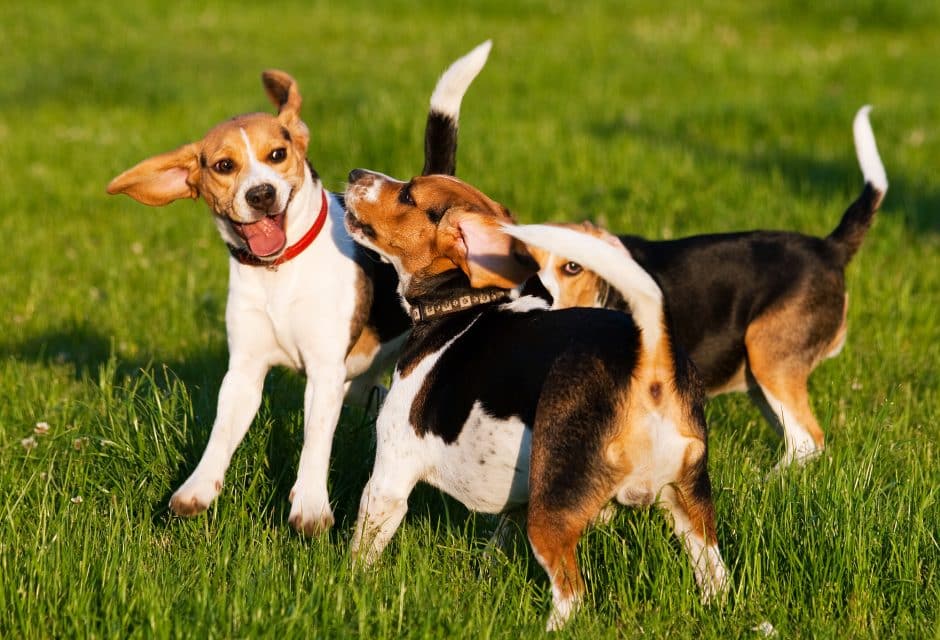

Problem Barking Solved!
The bark stops here! How to stop your dog from barking.
How many times have you observed this scenario? A dog gets excited and starts to bark. The owner begins to frantically yell at the dog, “No! Stop that!” Instead of becoming quiet, the dog begins to bark even more excitedly, and his master must now escalate his actions, and may ultimately resort to physical violence against his pet to try to achieve some quiet.
The real problem here is that the dog’s master does not understand the basics of dog language. To a dog, loud, short words like “No!” “Shut up!” “Don’t bark!” and so forth sound just like barks. Think of it this way: the dog barks to signal a potential problem. Now you (who are supposed to be leader of his pack) come over and also bark. This clearly indicates that you agree that this is the right time to sound the alarm, so the dog moves his barking to an even higher level.
Many different techniques have been tried to stop dogs from barking. They range from staring directly into the dog’s eyes in a threatening manner and shaking the dog to methods involving water pistols and squirt bottles, lemon juice sprays, muzzles, adhesive tape, rolled magazines, rattle cans and electric collars. Sometimes these work, but more often they don’t. Even when they do work, such methods tend to be harsh and can damage the relationship between dog and master.
To try to stop barking you must first understand what it means. The dog is barking to communicate something that he feels is relevant to the pack. Usually he is warning his loved ones that he senses danger or something else that requires action. Imagine what goes through the dog’s mind when his act of devotion is met by violence. Aggressive responses to communications that were meant to be helpful are bound to damage future relationships between the person and the dog. Furthermore, these “corrections” only provide a short-term solution to a problem that is easily solved if you understand canine communication patterns.
Wild canines, such as wolves, do not bark much as adults but they do bark as puppies. In the safety of the den area there is little harm in such noise; however, as the puppies grow older and begin to accompany the adults on hunts, such barking becomes counterproductive. A wolf puppy or adolescent who barks at an inappropriate time can alert potential prey that the pack is near, or attract the attention of other, larger predators. To stop this, a simple communication pattern has evolved. It obviously does not involve barking or any loud sound signal, since the goal is to stop noise. The signal also doesn’t involve direct aggression since nipping or biting the barker is apt to cause yelps of pain, growls, or dashing around to avoid or counter the aggressor’s physical violence. This would be just as likely to alert other animals as the original barking itself.
The procedure worked out by wild canines to stop barking is quite simple. Namely, a more dominant animal places its mouth over the offender’s muzzle, without actually biting, and then gives a short, low, breathy growl. The low growl will not be heard very far, and it is short in duration. The mouth over the muzzle is not actually inflicting pain, so there is no yelping or attempt to escape. Silence usually follows immediately.
Humans can mimic this behaviour to stop barking when the dog is nearby. With your dog sitting at your left side, slip the fingers of your left hand under the collar at the back of your dog’s neck. Pull up on the collar with your left hand, while your right hand folds over the top of the dog’s muzzle and presses down. In a quiet, businesslike and unemotional tone, you simply say, “Quiet.” Your left hand on the collar immobilizes the head. Your right hand serves the same function and communicates the same message as the leader’s mouth over the noisy animal’s muzzle. The softly spoken “Quiet” mimics the short, low and breathy growl. Repeat this silencing manoeuvre whenever it is necessary. Depending upon the breed, it may take anywhere from two to a couple of dozen repetitions to associate the calmly stated command, “Quiet,” with an end to barking.
Be sure, however, that you only use this procedure to stop a dog from barking when barking is excessive or unnecessary. Remember that we specifically bred dogs to bark, so if your dog sounds the alarm at the approach of a stranger, or even at the sight of a cat outside of your window, don’t correct him, just call him to your side and give him a quick pet or a rub, and maybe a quiet “Okay.” He will often stop by himself once you acknowledge the situation. By barking, your dog is only doing the job that humans designed him to do thousands of years ago.
Stanley Coren is a Professor of Psychology at the University of British Columbia and author of many books on dogs, including How to Speak Dog and Pawprints of History. His website is www.stanleycoren.com
This article originally appeared in the award-winning Modern Dog magazine. Subscribe today!
Join the newsletter and never miss out on dog content again!
"*" indicates required fields
By clicking the arrow, you agree to our web Terms of Use and Privacy & Cookie Policy. Easy unsubscribe links are provided in every email.





